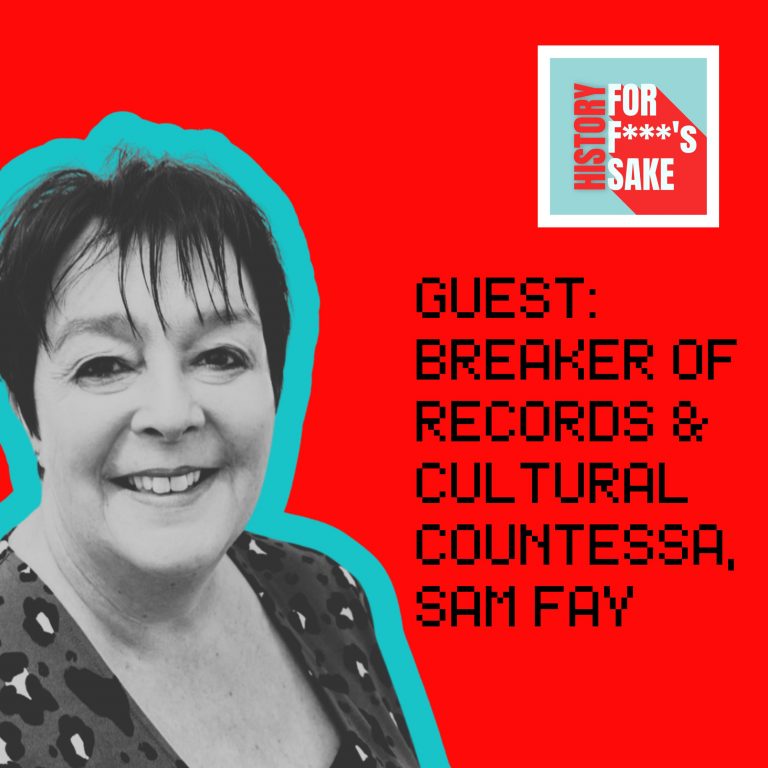
Did you ever wonder how we got here, and how sometimes tiny pieces of history make up, and have shaped our lives?
Or realised how every day, all of us are making history?
Join me, Sarah Dowd, in exploring what has happened in the everyday lives of people for the better, or at least the experiences that have just make us laugh and say…
This is… History. For F***’s Sake, the podcast that explores untold stories that make a difference.
When the world seemingly shut down for almost two years, what were we doing? We were creating art, making history and crying out of human contact. We were craving our culture.
I’m your host, Sarah Dowd, and I have worked on over 200 history, heritage and arts projects in the last 20 years across the world, everywhere from the Imperial War Museum in London to exploring how we put a fleet of ships in the sky, or bringing wrecks back from Honolulu.
I was recently diagnosed with ADHD which has brought a whole new layer of thinking about creativity and how we get people – ALL PEOPLE – really engaged with our shared history and culture.
Stories. Art. Film. Books. Ships. Music. Museums. People. Joy. Experiences. Humour. Humanity.
Because it’s all History, For F***’s Sake.
Find out more at historyffs.com
How did a brewer’s debate at a shooting party become a pop-culture phenomenon? Why is the world so obsessed with the biggest, wildest, and most WTF achievements imaginable? In this episode of History for F***’s Sake, Sarah Dowd sits down with former Guinness World Records publishing exec and cultural strategist Sam Fay for the untold, hilarious, and truly bonkers history of the Guinness Book of World Records.
From bar room brainwaves in 1950s Ireland to the Christmas tree bonanza, schoolyard squabbles, and TikTok challenges of today, Sarah and Sam uncover why the record book became a global obsession and how its tale is really one about hope, healing, joy, and postwar curiosity. Expect stories of weird and wonderful record holders, marketing genius, and the irresistible human urge to measure, compare, and compete all fuelled by the enduring power of shared spectacle.
Highlights:
- The accidental origin: how a question about birds and beer started it all
- The McWhirter twins: relentless fact-finders and the science of record-keeping
- Why the book outgrew the bar—and changed Christmas mornings forever
- Iconic record holders, from the tallest man to the most pierced woman, and the joy of celebrating human oddity
- How TV, then TikTok, made record breaking a global (and instant) spectacle
- Postwar Britain’s search for fun, facts, and a little hope after years of austerity
- The Guinness Book as a “curated snapshot” in time—why we still need it in the digital age
- What it means for museums, history, and the power of archived stories today
- Imagine the future: records in virtual reality, on Mars, or measuring joy and goosebumps
About Sam Fay:
Sam is a senior-level marketer with over 20 years’ experience in entertainment, gaming, tourism, and the experience economy – having worked for global brands such as LEGO, EA, and Guinness World Records.She has also delivered world-class immersive experiences with Layered Reality and the World Experience Organization, most recently delivering the inaugural London Experience Week 2025. Sam serves as the Marketing Trustee and Director at UNESCO’s Old Royal Naval College in Greenwich and is Founder of SuperchargedCMO.com delivering marketing services for global brands in the experience economy.
Connect with Sam:
LinkedIn: https://www.linkedin.com/in/sam-fay-44b5443/
Website: SuperchargedCMO.com
About Sarah Dowd:
I’m Sarah Dowd – writer, speaker, heritage and arts consultant, producer, and all-around nerd – here to share the stories of our past that make us laugh, gasp, and mutter: It’s History… For F***k’s Sake.
For 25+ years I’ve created immersive, inclusive experiences that bring history alive, from rallying Second World War convoys through London to staging performances between Pearly Kings and Gen Z creatives. My work spans museums, cathedral crypts, pop-up theatres, global brands, and community projects across the UK and beyond.
As a Canadian living between the UK and France (with a late ADHD diagnosis that fuels my curiosity and creativity), I zigzag through culture, history, and big ideas, but never boring ones.
Every week on HistoryFFS, we explore how history echoes through today, from Drag Race to prefab tiny houses, with voices from musicians to mischief-makers.
Follow @HistoryFFS – because we’re all making history, one ridiculous, wonderful moment at a time.
Connect with Sarah:
Website:www.historyffs.com
LinkedIn:https://www.linkedin.com/in/sarahdowd/
Patreon: HistoryFFS
YouTube: @HistoryFFSPod
Instagram: @historyFFSPod
TikTok: @historyffspod
Follow the show for new episodes exploring the objects, people, and moments that shaped our world. If you want the story AND the sound of the past, this is essential listening.

What do a shooting party, a brewer’s marketing gamble, and a pair of obsessively precise twins have to do with one of the most stolen books in library history? The latest episode of It’s History for F**’s Sake, hosted by Sarah, dives deep into a book that’s ignited curiosity across generations: the Guinness World Records. With special guest Sam Fay who worked for the company for 17 years, the episode is a fabulous journey through the colourful, competitive, and quirky history of the world’s most extraordinary records.
A Pub Argument, a Brewer’s Gamble, and an Unexpected Bestseller
The origin of Guinness World Records is as legendary as some of its listings. As Sam recounts, it all began in 1951 during a shooting party in County Wexford, Ireland. Sir Hugh Beaver, then managing director of Guinness Brewery, found himself embroiled in a debate about the fastest game bird. Unable to settle the matter, he realised there must be countless arguments like this happening in pubs everywhere. The solution? A fact-filled book designed to resolve pub disputes complete with a beer-proof cover to be stashed behind the bar. The first edition was never meant to be sold, but when it hit shelves in 1955, it swiftly became a Christmas number one bestseller.
Why Do We Love Records? Competition, Curiosity, and a Bit of Fun
Sarah and Sam explore what keeps people captivated by world records year after year. At its core, the book’s appeal lies in the spirit of competition and the universal desire to know “who’s the best?” whether that’s the tallest man, the fastest runner, or the person who can eat the most Smarties with chopsticks. As Sam reflects, it’s also about accessibility: “You don’t have to be Usain Bolt to enjoy it. You can trade knowledge and participate, even if just as an amazed reader.”
There’s also an enduring positive energy about the book. It celebrates human achievement both the intentional and accidental and brings people together across cultural and generational divides.
From a Book to a Global Media Empire
What started as a quirky marketing tool exploded in popularity thanks not only to its prominent place in Christmas stockings but also to the game-changing UK TV show “Record Breakers.” This transformed the book from a local tradition into a global phenomenon. Sam also highlights how Guinness used the book as a clever strategy to keep the Guinness name in every pub regardless of whether the bar served their beer.
The Role of the McWhirter Twins: Making Records Official
The fact-finding duo behind the original book, Ross and Norris McWhirter, were both journalists with a deep love for precision and measurement. Their rigorous approach gave the book its signature credibility making even the silliest records “officially amazing.” Their passion for sports journalism is why so many records were originally athletic, but over the years the scope has expanded to embrace the weird and wonderful.
From Page to TikTok: The Changing Face of Record Breaking
Technology has transformed the world of record breaking. Today, challengers can go global overnight thanks to smartphones and social media. Viral trends like the Ice Bucket Challenge or bottle-flipping stunts have democratised access “the pub is now in your phone,” Sam notes. But beneath it all, the instinct remains the same: sharing stories of human capability and curiosity.
The Power of Joy and Storytelling
More than just a catalogue of facts, Guinness World Records stands out as a snapshot of collective achievement, a source of joy, and a driver of cultural connection. Whether it’s a woman with thousands of piercings, the tallest man feeling small in New York, or the camaraderie of breaking records together, the book brings out the best in human nature. In an era often marked by negativity, both Sarah and Sam champion its continued relevance as a beacon of positivity and inspiration.
Looking Forward: New Records and New Frontiers
Where does record-breaking go from here? Sam imagines records in space, AI-powered measurements of emotions, and even more inclusive, global participation. The episode ends with a call to action encouraging listeners (and museums!) to find their own record-worthy stories and remember to celebrate the extraordinary in the everyday. This episode is a heartwarming, hilarious, and thought-provoking look at the Guinness World Records and why 70 years on it still captures our imagination.


